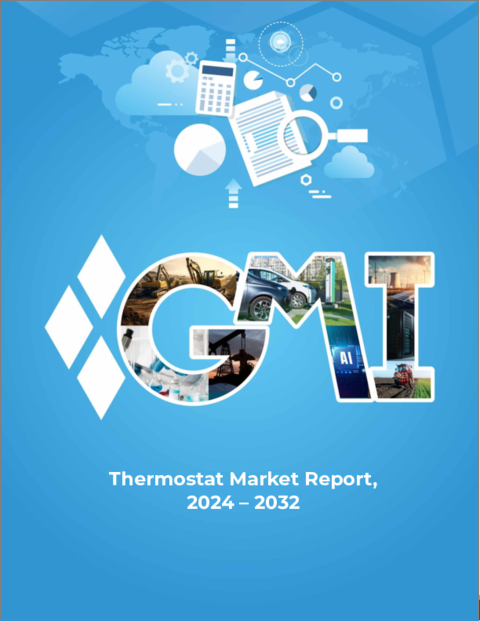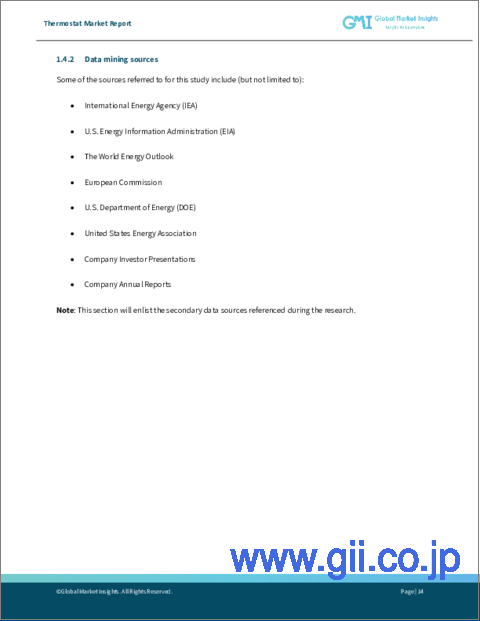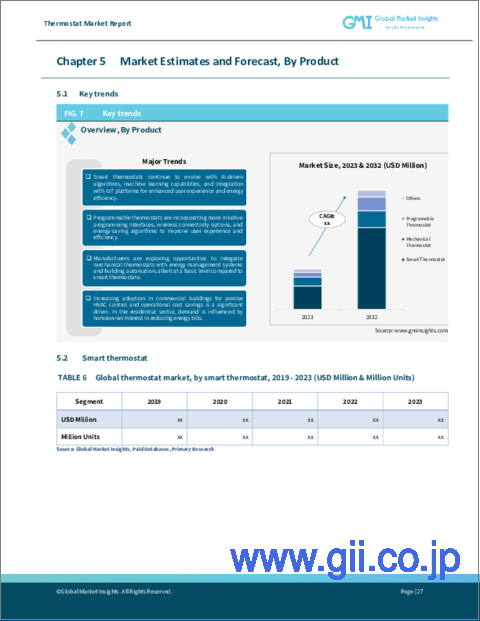|
|
市場調査レポート
商品コード
1354330
サーモスタットの市場規模:製品別、流通チャネル別、動作モード別、用途別&予測:2023~2032年Thermostat Market Size By Product, By Distribution Channel, By Mode of Operation, Application & Forecast, 2023 - 2032 |
||||||
カスタマイズ可能
|
|||||||
| サーモスタットの市場規模:製品別、流通チャネル別、動作モード別、用途別&予測:2023~2032年 |
|
出版日: 2023年07月03日
発行: Global Market Insights Inc.
ページ情報: 英文 500 Pages
納期: 2~3営業日
|
- 全表示
- 概要
- 目次
サーモスタットの世界市場は、2023年から2032年にかけて12.8%のCAGRが見込まれています。
エネルギー効率と気候変動に対する認識と関心の高まりにより、消費者と企業は同様に、より効率的な冷暖房方法を求めるようになっています。その結果、温度設定を最適化してエネルギー消費を削減できるスマート・サーモスタットへの需要が高まっています。
さらに、省エネルギー促進を目的とした政府の規制やインセンティブが、サーモスタット市場をさらに後押ししています。ニューヨーク州は、大規模なエネルギー・ユーザーに負荷の電化と排出量の削減を奨励するため、1,000万米ドル相当の商業・産業用加速効率化プログラムを導入しました。このような政策は、エネルギー効率の高い冷暖房ソリューションの採用を奨励し、ユーザーのエネルギー料金節約に役立つプログラマブル・スマート・サーモスタットの需要を押し上げています。
サーモスタット市場は、製品、流通チャネル、動作モード、用途、地域によって分類されます。
機械式サーモスタットは、その手頃な価格と信頼性により、2023~2032年のCAGRは7.1%超を記録します。スマート・サーモスタットやプログラマブル・サーモスタットが人気を博している一方で、機械式サーモスタットは予算が限られている消費者にとって費用対効果の高い選択肢であり続けています。特に先進技術の導入が制限されている地域では、そのシンプルさと耐久性が魅力となっています。さらに、簡単な操作と接続機能の欠如を好むユーザーもおり、市場における機械式サーモスタットの持続的な需要につながっています。
動作モードに基づくと、低電圧セグメントは最新のHVACシステムとの互換性が強化されているため、2032年までのCAGRは12.3%を超えると予想されます。低電圧サーモスタットは、最新の冷暖房システムで一般的な24ボルト電源を使用することが多いです。この互換性により、既存のインフラとシームレスに統合できるため、HVACシステムをアップグレードする住宅所有者にとって魅力的な選択肢となります。さらに、低電圧サーモスタットはエネルギー効率が高いことで知られており、持続可能なソリューションを求める環境意識の高い消費者にとって魅力的な製品となっています。
住宅用アプリケーション分野は、住宅リフォームとスマートホーム統合の動向の高まりにより、2023~2032年のCAGRが13.1%を超えると予測されます。居住空間のアップグレードに投資する住宅所有者が増えるにつれ、最新のエネルギー効率に優れたサーモスタットの設置が一般的な選択肢となります。さらに、住宅環境における快適性と利便性が重視されるようになり、ゾーニング、音声制御、学習機能などの高度な機能を提供するサーモスタットへの関心が高まり、この分野の需要をさらに促進しています。
北米のサーモスタット市場は2032年までCAGR12.0%以上を記録します。厳しい冬と暑い夏は効率的な冷暖房システムを必要とするため、住宅所有者はエネルギー・コストを管理しながら快適さを維持するために高度なサーモスタットに投資するようになります。さらに、北米では政府の取り組みや電力会社のリベートにより、エネルギー効率の高いソリューションの導入が奨励されており、同地域のサーモスタット需要をさらに促進しています。
目次
第1章 調査手法と調査範囲
第2章 エグゼクティブサマリー
第3章 サーモスタット業界考察
- エコシステム分析
- ベンダーマトリックス
- 規制状況
- 業界への影響要因
- 促進要因
- 業界の潜在的リスク&課題
- 成長可能性分析
- ポーター分析
- PESTEL分析
- 業界の展望に対するCOVID-19の影響
第4章 競合ベンチマーキング
- イノベーションと持続可能性の情勢
- 競合情勢、2022年
- 戦略ダッシュボード
第5章 サーモスタット市場:製品別
- 主要動向
- スマートサーモスタット
- 機械式サーモスタット
- プログラマブルサーモスタット
- その他
第6章 サーモスタット市場:流通チャネル別
- 主要動向
- ユーティリティ
- 小売
- セキュリティ
- 空調
第7章 サーモスタット市場:動作モード別
- 主要動向
- 低電圧
- ライン電圧
- ミリボルト
第8章 サーモスタット市場:用途別
- 主要動向
- 住宅
- 商業施設
- 教育機関
- オフィスビル
- 小売
- 病院
- その他
- 産業
第9章 サーモスタット市場:地域別
- 主要動向
- 北米
- 米国
- カナダ
- メキシコ
- 欧州
- 英国
- フランス
- ドイツ
- イタリア
- スウェーデン
- デンマーク
- スペイン
- ロシア
- アジア太平洋
- 中国
- 日本
- 韓国
- インド
- オーストラリア
- マレーシア
- インドネシア
- 中東・アフリカ
- UAE
- サウジアラビア
- カタール
- オマーン
- クウェート
- エジプト
- 南アフリカ
- ラテンアメリカ
- ブラジル
- アルゼンチン
- チリ
- ペルー
第10章 企業プロファイル
- Trane
- Legrand
- Schneider Electric
- Nortek Global HVAC
- Radio Thermostat Company of America
- COMPUTIME LIMITED
- Johnson Controls
- Danfoss
- Carrier Corporation
- Emerson Electric Co.
- Sensata Technologies, Inc.
- Trafag
- Venstar Inc.
- tado GmbH
- Lennox International Inc.
- Ecobee
Global Thermostat Market will witness a 12.8% CAGR between 2023-2032. the increasing awareness and concern about energy efficiency and climate change have led consumers and businesses alike to seek more efficient ways of heating and cooling their spaces. This has resulted in a growing demand for smart thermostats that can optimize temperature settings and reduce energy consumption.
Additionally, government regulations and incentives aimed at promoting energy conservation have further propelled the thermostat market. New York introduced a Commercial and Industrial Accelerated Efficiency Program worth USD 10 million to incentivize large energy users to electrify loads and mitigate emissions. These policies encourage the adoption of energy-efficient heating and cooling solutions, boosting the demand for programmable and smart thermostats that can help users save on energy bills.
The thermostat market is categorized based on product, distribution channel, mode of operation, application, and region.
The mechanical thermostat will record over 7.1% CAGR between 2023-2032, due to their affordability and reliability. While smart and programmable thermostats have gained popularity, mechanical thermostats remain a cost-effective choice for consumers on a budget. Their simplicity and durability make them appealing, particularly in regions where advanced technology adoption may be limited. Moreover, some users prefer the straightforward operation and lack of connectivity features, leading to sustained demand for mechanical thermostats in the market.
Based on mode of operation, the low voltage segment will exhibit over 12.3% CAGR through 2032, as they offer enhanced compatibility with modern HVAC systems. These thermostats often use a 24-volt power source, which is common in newer heating and cooling systems. This compatibility makes them an attractive choice for homeowners upgrading their HVAC systems, as they can seamlessly integrate with existing infrastructure. Additionally, low-voltage thermostats are known for their energy efficiency, making them appealing to environmentally conscious consumers seeking sustainable solutions.
The residential application segment will depict more than 13.1% CAGR over 2023-2032, due to the rising trend of home renovation and smart home integration. As more homeowners invest in upgrading their living spaces, the installation of modern, energy-efficient thermostats becomes a common choice. Moreover, the growing emphasis on comfort and convenience in residential settings has led to increased interest in thermostats that offer advanced features like zoning, voice control, and learning capabilities, further driving the demand in this sector.
North America thermostat market will record over 12.0% CAGR through 2032, driven by the extreme weather conditions experienced in many regions. Harsh winters and hot summers necessitate efficient heating and cooling systems, prompting homeowners to invest in advanced thermostats to maintain comfort while managing energy costs. Additionally, government initiatives and utility rebates in North America encourage the adoption of energy-efficient solutions, further fueling the demand for thermostats in the region.
Table of Contents
Chapter 1 Methodology & Scope
- 1.1 Market scope and definitions
- 1.2 Base estimates & calculations
- 1.3 Forecast calculations
- 1.4 Data sources
- 1.4.1 Primary
- 1.4.2 Secondary
- 1.4.2.1 Paid sources
- 1.4.2.2 Public sources
Chapter 2 Executive Summary
- 2.1 Thermostat industry 360 degree synopsis, 2019 - 2032
- 2.1.1 Business trends
- 2.1.2 Product trends
- 2.1.3 Distribution channel trends
- 2.1.4 Mode of operation trends
- 2.1.5 Application trends
- 2.1.6 Regional trends
Chapter 3 Thermostat Industry Insights
- 3.1 Industry ecosystem analysis
- 3.1.1 Vendor matrix
- 3.2 Regulatory landscape
- 3.3 Industry impact forces
- 3.3.1 Growth drivers
- 3.3.2 Industry pitfalls & challenges
- 3.4 Growth potential analysis
- 3.5 Porter's Analysis
- 3.5.1 Bargaining power of suppliers
- 3.5.2 Bargaining power of buyers
- 3.5.3 Threat of new entrants
- 3.5.4 Threat of substitutes
- 3.6 PESTEL Analysis
- 3.7 COVID- 19 impact on the industry outlook
Chapter 4 Competitive Benchmarking
- 4.1 Innovation & sustainability landscape
- 4.2 Competitive landscape, 2022
- 4.2.1 Strategy dashboard
Chapter 5 Thermostat Market, By Product
- 5.1 Key product trends
- 5.2 Smart thermostat
- 5.3 Mechanical thermostat
- 5.4 Programmable thermostat
- 5.5 Others
Chapter 6 Thermostat Market, By Distribution Channel
- 6.1 Key distribution channel trends
- 6.2 Utility
- 6.3 Retail
- 6.4 Security
- 6.5 HVAC
Chapter 7 Thermostat Market, By Mode of Operation
- 7.1 Key mode of operation trends
- 7.2 Low voltage
- 7.3 Line voltage
- 7.4 Millivolt
Chapter 8 Thermostat Market, By Application
- 8.1 Key application trends
- 8.2 Residential
- 8.3 Commercial
- 8.3.1 Educational institutes
- 8.3.2 Office buildings
- 8.3.3 Retail
- 8.3.4 Hospitals
- 8.3.5 Others
- 8.4 Industrial
Chapter 9 Thermostat Market, By Region
- 9.1 Key regional trends
- 9.2 North America
- 9.2.1 U.S.
- 9.2.2 Canada
- 9.2.3 Mexico
- 9.3 Europe
- 9.3.1 UK
- 9.3.2 France
- 9.3.3 Germany
- 9.3.4 Italy
- 9.3.5 Sweden
- 9.3.6 Denmark
- 9.3.7 Spain
- 9.3.8 Russia
- 9.4 Asia Pacific
- 9.4.1 China
- 9.4.2 Japan
- 9.4.3 South Korea
- 9.4.4 India
- 9.4.5 Australia
- 9.4.6 Malaysia
- 9.4.7 Indonesia
- 9.5 Middle East & Africa
- 9.5.1 UAE
- 9.5.2 Saudi Arabia
- 9.5.3 Qatar
- 9.5.4 Oman
- 9.5.5 Kuwait
- 9.5.6 Egypt
- 9.5.7 South Africa
- 9.6 Latin America
- 9.6.1 Brazil
- 9.6.2 Argentina
- 9.6.3 Chile
- 9.6.4 Peru
Chapter 10 Company Profiles
- 10.1 Trane
- 10.2 Legrand
- 10.3 Schneider Electric
- 10.4 Nortek Global HVAC
- 10.5 Radio Thermostat Company of America
- 10.6 COMPUTIME LIMITED
- 10.7 Johnson Controls
- 10.8 Danfoss
- 10.9 Carrier Corporation
- 10.10 Emerson Electric Co.
- 10.11 Sensata Technologies, Inc.
- 10.12 Trafag
- 10.13 Venstar Inc.
- 10.14 tado GmbH
- 10.15 Lennox International Inc.
- 10.16 Ecobee






